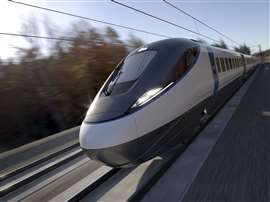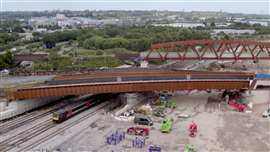WATCH: Balfour Beatty Vinci JV places new 84m bridge for UK HS2 megaproject
13 August 2024
A joint venture of construction contractors including UK-based Balfour Beatty and French firm Vinci placed an 84m bridge in Birmingham, England, UK, last weekend, as activity on the HS2 transportation megaproject continues.
 An artist’s impression of an HS2 train. (Image: HS2)
An artist’s impression of an HS2 train. (Image: HS2)
The JV moved the 1,600-tonne steel and concrete bridge over existing railway tracks in northeast Birmingham using two self-propelled modular transporters (SPMT). Moving and fixing took about five hours amid a Network Rail blockade from about 10 p.m. on 10 August to 3 a.m. the next day.
Dan Binns, project manager with Balfour Beatty Vinci said, “This was a complex operation, made even more challenging because the bridge needed to be driven over four existing Network Rail lines, requiring years of precise planning and preparation.”
To arrange for the move, a 9,000m2 platform was erected and 62 piles constructed to support concrete structures. Around 4,000m3 of concrete and 490 tonnes of reinforced steel was used in the operation, said Balfour Beatty.
Delivering the passagage along with Balfour Beatty Vinci was specialist bridge-moving contractor Mammoet. Balfour Beatty said the Netherlands-based heavy-lifting engineering firm moved the bridge into place using two 128-wheeled SPMTs across a matting bed, which was put over the tracks by UK-based engineering specialist Pod-Trak.
“We purposely chose to move the bridge on wheels, so it could be built offline first, then moved across in just five hours, greatly reducing the impact on rail passengers,” added Binns.
The HS2 high-speed train project in the UK is a projected £65 billion build that seeks to connect the English cities of Birmingham and London with a new railway line. Construction started in 2017 and is expected to finish around 2030.
About the HS2 project Aston Church Road bridge
 The Aston Church Road bridge in Birmingham, England, UK, is placed from 10-11 August by the Balfour Beaty Vinci HS2 joint venture. (Image: Balfour Beatty)
The Aston Church Road bridge in Birmingham, England, UK, is placed from 10-11 August by the Balfour Beaty Vinci HS2 joint venture. (Image: Balfour Beatty)
Called the Aston Church Road bridge, the structure was designed by a joint venture of UK-based design and engineering firms Mott MacDonald and Systra.
“The design incorporates local feedback, with a wide pedestrian walkway creating enough space for cyclists, an LED lighting strategy to enhance safety, and new woodland planting around the bridge,” said Balfour Beatty. “Public feedback resulted in the stainless steel finish being replaced with weathered steel panels incorporating a perforated pattern to maximise light and views, making the bridge feel warmer and improving the pedestrian experience.”
The bridge is 84m long by 21m wide and now sits over the existing Birmingham to Derby railway line.
The composite bridge is made of a concrete deck cast over steel girders with glass reinforced plastic panels used as permanent formwork, said Balfour Beatty.
UK concrete frame specialist MPB delivered the reinforced concrete works.
At present, the bridge sits on three structures: an abutment to the west of the existing rail tracks, a pier consisting of two columns on the east of the existing tracks, and an abutment to the east of the pier.
“In the coming weeks, all the other structures around the bridge, along with the steel assembly of the parapet panels, will be completed,” said Balfour Beatty.
Over the next 14 months, the JV will demolish the original Aston Church Road to create space for the HS2 line to pass through, and work will commence on connecting the new bridge to the existing road network.
Watch the Aston Church Road bridge move below.



